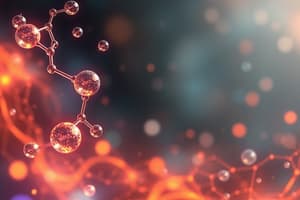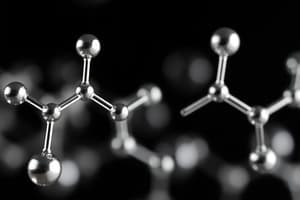Podcast
Questions and Answers
Which statement accurately describes the relationship between sigma (σ) and pi (π) bonds in organic compounds?
Which statement accurately describes the relationship between sigma (σ) and pi (π) bonds in organic compounds?
- Sigma (σ) bonds are weaker than pi (π) bonds and are primarily responsible for the reactivity of alkanes.
- Pi (π) bonds are the only type of bond found in saturated hydrocarbons, providing the foundation of their structure.
- Sigma (σ) bonds are formed by end-on overlap of atomic orbitals, providing greater bond strength and stability compared to pi (π) bonds. (correct)
- Pi (π) bonds are formed by end-on overlap of atomic orbitals, while sigma (σ) bonds are formed by sideways overlap of p orbitals.
Consider a molecule with the formula C6H12. Which of the options is least likely to reflect what this molecule is?
Consider a molecule with the formula C6H12. Which of the options is least likely to reflect what this molecule is?
- An alkyne with one triple bond (correct)
- Alkene with one double bond
- An alkane with two rings
- A cycloalkane
What distinguishes structural isomers from stereoisomers?
What distinguishes structural isomers from stereoisomers?
- Structural isomers are non-superimposable mirror images, while stereoisomers are identical molecules.
- Structural isomers have different connectivity of atoms, whereas stereoisomers have the same connectivity but different spatial arrangements. (correct)
- Structural isomers rotate plane-polarized light, while stereoisomers do not.
- Structural isomers have the same connectivity but different spatial arrangements, while stereoisomers have different connectivity of atoms.
During an electrophilic aromatic substitution reaction, a substituent on the aromatic ring is described as 'ortho-directing'. What does this imply about the incoming electrophile?
During an electrophilic aromatic substitution reaction, a substituent on the aromatic ring is described as 'ortho-directing'. What does this imply about the incoming electrophile?
Which statement accurately describes the key difference between SN1 and SN2 reactions?
Which statement accurately describes the key difference between SN1 and SN2 reactions?
What is the significance of the Cahn-Ingold-Prelog (CIP) priority rules in stereochemistry?
What is the significance of the Cahn-Ingold-Prelog (CIP) priority rules in stereochemistry?
A molecule is found to rotate plane-polarized light. What can be definitively concluded about this molecule?
A molecule is found to rotate plane-polarized light. What can be definitively concluded about this molecule?
What information does the molecular ion peak (M+) provide in mass spectrometry?
What information does the molecular ion peak (M+) provide in mass spectrometry?
In infrared (IR) spectroscopy, what type of information does the absorption of infrared radiation by a molecule provide?
In infrared (IR) spectroscopy, what type of information does the absorption of infrared radiation by a molecule provide?
How does Nuclear Magnetic Resonance (NMR) spectroscopy provide information about the structure of organic molecules?
How does Nuclear Magnetic Resonance (NMR) spectroscopy provide information about the structure of organic molecules?
Flashcards
Organic Chemistry
Organic Chemistry
Study of carbon-containing compounds' structure, properties, composition, reactions, and preparation.
Functional Groups
Functional Groups
Specific groups of atoms within molecules responsible for characteristic chemical reactions.
Isomers
Isomers
Molecules with the same molecular formula but different structural or spatial arrangements.
IUPAC Nomenclature
IUPAC Nomenclature
Signup and view all the flashcards
Alkanes
Alkanes
Signup and view all the flashcards
Aromatic Compounds
Aromatic Compounds
Signup and view all the flashcards
Markovnikov's Rule
Markovnikov's Rule
Signup and view all the flashcards
Addition Reactions
Addition Reactions
Signup and view all the flashcards
Chirality
Chirality
Signup and view all the flashcards
NMR Spectroscopy
NMR Spectroscopy
Signup and view all the flashcards
Study Notes
- Organic chemistry is the study of the structure, properties, composition, reactions, and preparation of carbon-containing compounds.
Key Concepts in Organic Chemistry
- Carbon's unique ability to form stable covalent bonds with itself and other elements is foundational.
- Organic molecules are primarily composed of carbon and hydrogen atoms, but also include nitrogen, oxygen, halogens, phosphorus, silicon, and sulfur.
- The arrangement of atoms and bonds in a molecule determines its properties and reactivity.
Bonding in Organic Compounds
- Carbon forms four covalent bonds.
- Single, double, and triple bonds between carbon atoms are common.
- Sigma (σ) bonds are formed by end-on overlap of atomic orbitals.
- Pi (π) bonds are formed by sideways overlap of p orbitals.
Functional Groups
- Functional groups are specific groups of atoms within molecules that are responsible for the characteristic chemical reactions of those molecules.
- Alkanes contain only single bonds, while alkenes contain at least one double bond, and alkynes contain at least one triple bond.
- Alcohols contain a hydroxyl group (-OH), ethers contain an oxygen atom bonded to two alkyl or aryl groups (R-O-R'), and amines contain a nitrogen atom bonded to alkyl or aryl groups.
- Aldehydes contain a carbonyl group (C=O) with at least one hydrogen atom attached, ketones contain a carbonyl group bonded to two alkyl or aryl groups, and carboxylic acids contain a carboxyl group (-COOH).
- Esters are derivatives of carboxylic acids where the hydrogen atom of the carboxyl group is replaced by an alkyl or aryl group (R-COO-R').
- Amides contain a nitrogen atom bonded to a carbonyl group.
Isomerism
- Isomers are molecules with the same molecular formula but different structural or spatial arrangements.
- Structural isomers have different connectivity of atoms.
- Stereoisomers have the same connectivity but different spatial arrangements.
- Enantiomers are non-superimposable mirror images.
- Diastereomers are stereoisomers that are not enantiomers.
- Cis-trans isomers (geometric isomers) occur when there is restricted rotation around a bond (e.g., double bonds or cyclic structures).
Nomenclature
- IUPAC nomenclature provides a systematic way to name organic compounds that is universally understood.
- Identify the parent chain, which is the longest continuous chain of carbon atoms.
- Number the carbon atoms in the parent chain to give the lowest possible numbers to substituents.
- Name and number the substituents.
- Combine the substituent names, numbers, and parent chain name into a single name.
- Functional groups have specific suffixes and prefixes.
Alkanes
- Alkanes are saturated hydrocarbons with the general formula CnH2n+2.
- They are relatively unreactive due to the strong C-C and C-H bonds.
- Alkanes undergo combustion, halogenation, and cracking reactions.
- Cycloalkanes are cyclic alkanes with the general formula CnH2n.
Alkenes and Alkynes
- Alkenes are unsaturated hydrocarbons with at least one carbon-carbon double bond.
- Alkynes are unsaturated hydrocarbons with at least one carbon-carbon triple bond.
- Alkenes and alkynes are more reactive than alkanes due to the presence of π bonds.
- They undergo addition reactions, such as hydrogenation, halogenation, hydrohalogenation, and hydration.
- Markovnikov's rule states that in the addition of HX to an alkene, the hydrogen atom adds to the carbon atom with more hydrogen atoms already attached.
Aromatic Compounds
- Aromatic compounds are cyclic, planar molecules with a delocalized π electron system.
- Benzene is the most common aromatic compound.
- Aromatic compounds undergo electrophilic aromatic substitution reactions, such as halogenation, nitration, sulfonation, and Friedel-Crafts alkylation and acylation.
- Substituents on the aromatic ring can be activating or deactivating, and ortho-, para-, or meta-directing.
Reactions
- Addition reactions involve the addition of atoms or groups of atoms to a molecule, typically at a multiple bond.
- Elimination reactions involve the removal of atoms or groups of atoms from a molecule, typically forming a multiple bond.
- SN1 reactions are unimolecular nucleophilic substitution reactions that proceed through a carbocation intermediate.
- SN2 reactions are bimolecular nucleophilic substitution reactions that occur in one step.
- Electrophilic Aromatic Substitutions (EAS) involve the substitution of an atom (usually hydrogen) on an aromatic ring by an electrophile.
- Oxidation reactions involve an increase in the oxidation state of a carbon atom, while reduction reactions involve a decrease in the oxidation state.
Stereochemistry
- Chirality refers to the property of a molecule that is non-superimposable on its mirror image (enantiomer).
- A chiral center is a carbon atom bonded to four different groups.
- Enantiomers have identical physical properties except for the direction in which they rotate plane-polarized light.
- A racemic mixture is a mixture containing equal amounts of both enantiomers.
- Optical activity is the ability of a chiral molecule to rotate plane-polarized light.
- Diastereomers have different physical properties.
- Meso compounds contain chiral centers but are achiral due to internal symmetry.
- The Cahn-Ingold-Prelog (CIP) priority rules are used to assign R and S configurations to chiral centers.
Spectroscopy
- Spectroscopy is the study of the interaction of electromagnetic radiation with matter.
- Nuclear Magnetic Resonance (NMR) spectroscopy provides information about the structure and bonding environment of atoms in a molecule.
- Chemical shift is the position of a signal in an NMR spectrum, which is influenced by the electronic environment of the atom.
- Splitting of NMR signals is caused by spin-spin coupling between neighboring atoms.
- Infrared (IR) spectroscopy provides information about the functional groups present in a molecule based on the absorption of infrared radiation.
- Characteristic IR absorption bands are associated with specific functional groups.
- Mass spectrometry (MS) provides information about the molecular weight and fragmentation pattern of a molecule.
- The molecular ion peak (M+) corresponds to the molecular weight of the compound.
- Fragmentation patterns can provide clues about the structure of the molecule.
- Ultraviolet-Visible (UV-Vis) spectroscopy provides information about the electronic transitions in a molecule.
- UV-Vis spectroscopy is often used to study conjugated systems and aromatic compounds.
Studying That Suits You
Use AI to generate personalized quizzes and flashcards to suit your learning preferences.




